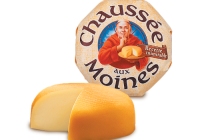
Chaussée aux Moines cheese - Made by Trappist monks the secret recipe is inimitable, more flavorful than a Saint-Paulin.

New year's traditions around the world

For the new year, restaurants feature legumes, said to promise abundance for the coming months, or piglet for luck. However, don't look for rabbit, chicken or fish on the menu: they may signify your luck fleeing, flying or swimming away in the new year!

Basler Läckerli were created during the Council of Basel (1431-1449) for the church representatives. The name, from the German lecker (delicious), came about in 1720, to refer to these little square cookies that are a cousin to gingerbread. In fact, they can be spice-based, containing cinnamon, nutmeg and cloves, or made from honey, almonds and dried fruits. Usually served to celebrate the new year, they have become iconic in Basel. Aficiondados have a special technique for eating them: they break them into little pieces and let them dissolve on the tongue.
> Click here to view the recipe.

The New Year's meal is always served in the home of the head of the family. Each food is specially chosen because it is a symbol of happiness. The most important food is certainly mochi, sticky rice that is boiled and ground to make the traditional cakes that mark the new year.
> Click here to read more about Japanese new year traditions.

In Britain, the ceremony of First Footing is traditionally observed in the early hours of New Year's Day. A piece of bread is left outside a door, with a piece of coal and a silver coin, and is supposed to bring you food, warmth and riches in the year ahead.
Godcakes were handed out at the beginning of the year by godparents to godchildren. Historically, those fluffy treats ranged in size and price, depending on the pocket and / or generosity of the godparent.
> Click here for the recipe.

Who will see the new year under the auspices of gold and silver?
The St. Basil cake is traditionally placed in the centre of the table and always contains a piece of gold. The honour of cutting the cake falls to the father of the family at the stroke of midnight.
You will find also pile of kourabiedes, thick cookies generously dusted with powdered sugar.

The Oliebollen are small ball-shaped doughnuts stuffed with raisins and currants, sprinkled generously with icing sugar, as if they were snow-capped. It is traditional to serve oliebollen to celebrate the arrival of the new year with a glass of champagne. ...

Saurkraut with smoked sausages

One of the most popular winter dishes in Croatia is the tasty stuffed rolled cabbage leaves known as Sarma. It is a winter staple traditionally served on New Year’s Eve, generously stuffed with meat, rice and seasoned with paprika.

In Haiti, New Year's has particular significance. It is also Haitian Independence Day. Since 1804, as the new year begins, Haitians celebrate by sharing their famous "joumou" soup, made from giraumon (a kind of Caribbean pumpkin), beef, vegetables, spices and pasta, a symbol of freedom and victory.
Click here to view the tradition and recipe.

It is a fun and unusual tradition in Puerto Rico to eat 12 grapes at Midnight! The clock chimes 4 times to warn you to get your grapes ready and then at midnight there are 12 chimes – one for every grape – Each grape representing the 12 months of the year. If you manage to eat all 12 grapes it is supposed to bring you luck and prosperity for the coming year. People also throw sugar around the house for the same reasons, and throw buckets of water through the windows to dispel the negative thoughts accumulated during the year.
You will find also the grape tradition in Spain.

The sweet finale comes in the form of a Kransekage, a towering cake made from layer-upon-layer of marzipan rings. The cake’s turret-like shape is reminiscent of a cornucopia, the horn of plenty, which promises happiness and wealth for the coming year. Godt Nytår (Happy New Year).
> Click here to view the tradition and recipe.

-

 Recipes
Recipes
-

 Products
Products
-

 Entertaining
Entertaining
-

 Chefs
Chefs
-

 Hints & Tips
Hints & Tips
-

 Glossaries
Glossaries








